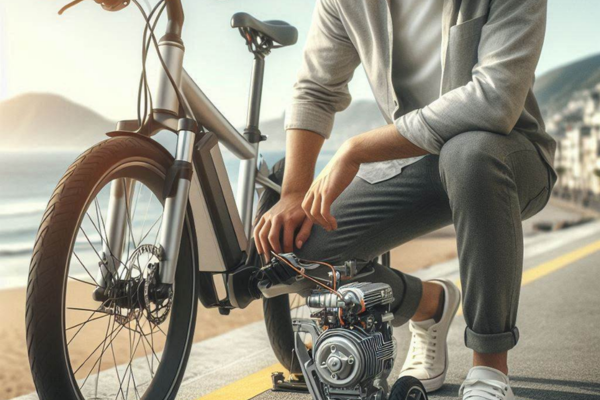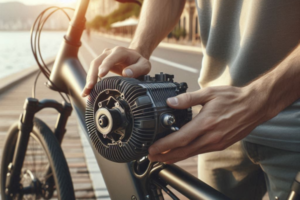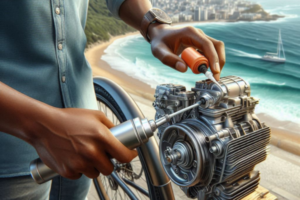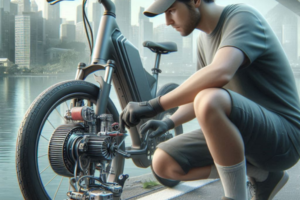Preventive Maintenance: How to Care for the Motor of Your Electric Bike in Coastal Areas
 Why Coastal Environments Are Tough on E-Bike Motors
Why Coastal Environments Are Tough on E-Bike Motors
Coastal cities offer breathtaking views, fresh air, and the kind of freedom that only ocean-adjacent cycling can provide. But for electric bicycles, the coast presents a hidden challenge: salt, moisture, and fine particulate matter in the air that can wear down mechanical and electronic components over time — especially the motor.
While most riders focus on tire pressure or battery range, the motor is the heart of your e-bike, and in coastal areas, it faces a silent battle against corrosion, condensation, and heat. Unlike visible issues like rust on bolts or fading paint, motor damage often begins internally. Salty air seeps through gaps, collects as residue, and begins to degrade the connections, bearings, and magnets inside your motor housing.
The solution isn’t to fear the coast — it’s to prepare for it. With consistent, thoughtful, and preventive maintenance, you can ride your electric bicycle along beaches and through humid sea breeze without worrying that each ride is reducing your motor’s lifespan.
 Coastal Air: A Technical Threat to Motors
Coastal Air: A Technical Threat to Motors
Coastal air is rich in microscopic salt particles that remain suspended even miles from the shoreline. When combined with high humidity and frequent temperature shifts, this environment accelerates two main risks for your motor:
Corrosion of connectors and coils: Salt attracts moisture, which facilitates electrochemical reactions that corrode metal. This can interrupt electrical signals, reduce motor efficiency, and eventually cause failure.
Thermal fatigue from poor heat dissipation: Salt buildup insulates the motor, trapping heat inside. Coastal areas also tend to have warmer climates, further stressing the internal temperature regulation of your motor.
These effects are often subtle at first: a slight drop in torque, a faint whining sound, or uneven acceleration. But left unchecked, they can escalate quickly — especially in e-bikes with daily use near the ocean.
 A New Mindset: Preventive, Not Reactive
A New Mindset: Preventive, Not Reactive
Many e-bike owners wait for something to go wrong before taking action. But in coastal climates, waiting can be costly. The best approach is preventive maintenance: small, regular actions designed to prevent larger problems before they start.
Just like brushing your teeth prevents cavities, wiping your motor after a salty ride, or inspecting a cable seal once a week can prevent deeper, more expensive damage. It’s about shifting from repair to protection — and empowering yourself to keep your motor strong, silent, and reliable.
 Thought to Start With
Thought to Start With
“The ocean doesn’t need to be feared — only respected. Your motor, like your journey, lasts longer when you care before it breaks.”
In the blocks that follow, you’ll discover the most effective preventive maintenance strategies — not just technical fixes, but habits and upgrades that help you live in harmony with your coastal surroundings. Because every ride near the sea should be joyful, not stressful.
 Technologies That Help Prevent Motor Damage in Coastal Climates
Technologies That Help Prevent Motor Damage in Coastal Climates
If you’re cycling regularly along the coast, relying on smart maintenance alone isn’t enough. The good news is that today’s electric bicycle technologies are evolving quickly, and several innovations can serve as proactive shields for your motor. Whether you’re buying a new bike or upgrading your current one, these features and accessories can make a significant difference in humid, salt-rich environments.
 1. High-Grade Motor Enclosures (IP Ratings)
1. High-Grade Motor Enclosures (IP Ratings)
When choosing an e-bike for coastal use, always look at the IP (Ingress Protection) rating. A rating of IP65 or higher means the motor is sealed tightly against dust and water spray. For riders who live very close to the shoreline, an IP67 or IP68 rating is even better — these motors can withstand immersion in water for limited durations, offering additional protection from coastal rain, puddles, and salt exposure.
 2. Waterproof Connectors and Corrosion-Resistant Cabling
2. Waterproof Connectors and Corrosion-Resistant Cabling
Your motor relies on a network of power and communication cables that connect it to the controller and battery. These cables are often overlooked, but they are prime entry points for moisture and corrosion. Look for gold-plated, silicone-sealed connectors, often labeled as “marine-grade,” to prevent salt and moisture from degrading the signal and power flow.
 3. Protective Sprays and Sealants
3. Protective Sprays and Sealants
There are products specifically designed to combat moisture and salt exposure. For instance, applying ACF-50 or Boeshield T-9 to the motor casing, bolts, and connector points can provide an invisible film that repels water and halts corrosion. These sprays should be reapplied every 3–4 weeks in coastal environments for continued protection.
 4. Smart Diagnostic Systems
4. Smart Diagnostic Systems
Some modern e-bike systems (like Bosch, Shimano STEPS, or Bafang) come with companion apps that offer live diagnostics. These apps detect changes in motor resistance, power draw, and temperature — all of which can be early indicators of salt-induced damage. Real-time alerts allow you to take action before small issues become serious.
 5. Passive Ventilation Design
5. Passive Ventilation Design
In warm coastal cities, heat buildup can be just as dangerous as salt. Motors with passive airflow systems (vent channels or thermal wraps) release excess heat before it can mix with humidity and condense inside the housing. This passive cooling helps reduce internal stress and protects against hidden rust.
 Comparison Table: Standard vs. Coastal-Ready Motor Features
Comparison Table: Standard vs. Coastal-Ready Motor Features
| Component | Standard Setup | Coastal-Optimized Setup |
|---|---|---|
| Motor Enclosure | IP54 (basic splash resistance) | IP67 (dust-tight and waterproof) |
| Connectors | Standard plugs | Marine-grade waterproof with seals |
| Protection Products | None or general-purpose spray | Specialized anti-corrosion film |
| Monitoring | LED indicator lights | App-based smart diagnostics |
 Reflection on Preparedness
Reflection on Preparedness
“Technology is not just for power — it’s for protection. When your motor is equipped for the coast, every ride becomes a form of freedom.”
You don’t need to be a tech expert to protect your ride. A few smart decisions can give your motor the armor it needs to resist the sea’s soft but relentless breath.
 Real Story: Luis’ Journey to Motor Longevity in Barranquilla
Real Story: Luis’ Journey to Motor Longevity in Barranquilla
Luis, a delivery rider in Barranquilla, Colombia, depended on his electric bicycle to navigate the city’s busy coastal streets. While his motor worked beautifully during the first rainy season, he began to notice slight jerks in acceleration and occasional clicking sounds. Thinking it was a controller issue, he kept riding — until one afternoon his motor simply stopped mid-route.
A local technician opened the hub motor and found internal rust along the magnet edges, mild coil discoloration, and salt residue near the connector base. The diagnosis was clear: moisture had infiltrated over weeks, not days. The technician managed to clean and reseal the unit, but warned Luis: “It’s not about riding less — it’s about maintaining more.”
From that day forward, Luis adopted a preventive care routine. Weekly wipe-downs, monthly use of anti-corrosion spray, and a connector cover became part of his work tools — just like his phone and charger. Over a year later, Luis’ motor was not only functional, but smoother, quieter, and more efficient than ever. He became known among fellow riders as “el que nunca para.”
 Simple Daily and Weekly Habits That Protect Your Motor
Simple Daily and Weekly Habits That Protect Your Motor
You don’t need to overhaul your e-bike or spend a fortune to take better care of your motor. In fact, the most effective strategies are often the simplest — and they can be done at home, in less than 15 minutes per week. Here are key preventive habits for coastal riders:
Daily: Wipe down the motor casing with a soft cloth after any ride through salty air, mist, or rain.
Weekly: Inspect the motor area for signs of white residue (salt), rust stains, or cable discoloration.
Weekly: Check connector tightness and seals — gently press them to ensure no gap has formed.
Monthly: Reapply anti-corrosion spray to bolts, seams, and outer casing areas of the motor.
Monthly: Remove the battery (if detachable) and inspect terminals for oxidation or moisture buildup.
These small steps form a barrier between your motor and its coastal environment. You don’t need mechanical skills — only consistency and awareness.
 Coastal Wisdom from Experience
Coastal Wisdom from Experience
“The salt doesn’t care how much you paid for your motor — but it will respect how well you protect it.”
Luis’ story shows that you don’t need perfect conditions to ride far. You just need good habits, smart protection, and the belief that every ride is worth caring for. Preventive maintenance isn’t about avoiding the coast — it’s about riding it on your terms.
 Common Mistakes That Sabotage Motor Health in Coastal Areas
Common Mistakes That Sabotage Motor Health in Coastal Areas
Even the most well-meaning e-bike owners often fall into habits that increase the risk of motor damage — especially when riding near the sea. In coastal environments, simple oversights can invite moisture, salt, and heat stress into your motor system without you even realizing it. Recognizing and avoiding these common mistakes is a powerful first step in any preventive care strategy.
Rinsing the bike with a garden hose or pressure washer: Even sealed motors can be breached when exposed to direct water jets. This forces moisture past gaskets and into sensitive electronic components.
Leaving the bike parked in full sun near the ocean: Heat buildup mixed with salt particles creates condensation inside motor housings — especially when the bike later cools down in shade or at night.
Using petroleum-based or general-purpose lubricants: These break down faster in humid conditions and attract dust and salt, which stick to the motor and accelerate wear.
Neglecting firmware updates on smart motors: Some motors have thermal or moisture-related protections that are improved via updates. Ignoring these can reduce efficiency and response to environmental stress.
Failing to inspect connectors after rain or heavy mist: Even waterproof connectors can loosen or wear over time. Just one exposed pin can begin to corrode silently.
Avoiding these mistakes not only prevents damage but gives you more control over your ride. Your motor works hard for you — it deserves small acts of protection in return.
 Preventive Maintenance Checklist for Coastal Riders
Preventive Maintenance Checklist for Coastal Riders
Print this checklist and keep it near your storage space. These steps are simple but powerful. Make them part of your weekly and monthly routine:
Daily: Wipe motor and connector areas with a soft, dry cloth after each ride near saltwater or in humid conditions.
Weekly: Inspect connector plugs for signs of corrosion or discoloration.
Weekly: Check casing seams and bolts for white or orange powdery build-up (early rust).
Monthly: Apply anti-corrosion spray or dielectric grease to all accessible exterior metal surfaces.
Monthly: Remove battery (if possible) and inspect terminals for signs of moisture or green-blue residue.
Quarterly: Update firmware using your e-bike app (if available).
As needed: Replace gaskets or cable sleeves showing cracks or wear.
These simple actions require no special tools or technical knowledge. They offer a powerful way to extend the life and reliability of your motor in one of the harshest riding environments.
 A Reminder from the Sea
A Reminder from the Sea
“Salt and moisture don’t rush — they linger. But so can your motor, if you meet them with care, not silence.”
Prevention is not a one-time act — it’s a relationship. Every time you check, clean, or protect your motor, you’re affirming that your ride matters, and your path deserves to be smooth, strong, and sustainable.
 Frequently Asked Questions (FAQs)
Frequently Asked Questions (FAQs)
Can I ride my e-bike daily near the ocean without damaging the motor?
Yes — but only if you follow a preventive maintenance routine. Riding near the sea introduces salt particles and humidity into your motor’s environment. Without regular care, these can cause corrosion or electronic faults over time. However, with proper cleaning, sealing, and protective habits, you can ride safely every day.
What’s the best product to use for anti-corrosion on e-bike motors?
Specialized sprays like ACF-50, Boeshield T-9, or WD-40 Specialist (not regular WD-40) are excellent choices. They create a light film over metallic surfaces to block moisture and salt. For connectors and terminals, use dielectric grease — it’s non-conductive and moisture-resistant.
How do I know if moisture is affecting my motor?
Look out for signs like reduced torque, power cuts, odd noises, or visible corrosion on connectors. Some motors also include diagnostic apps that alert you to abnormal internal behavior (e.g., increased resistance, overheating, or erratic voltage use).
What should I avoid when cleaning my e-bike motor?
Avoid high-pressure water, strong solvents, or scrubbing with abrasive materials. Never spray directly into vents or connectors. Instead, use a soft microfiber cloth, light mist of cleaner (if needed), and keep the area dry before reconnecting anything.
Is indoor storage always necessary?
Indoor storage is ideal, but if not possible, choose a shaded and well-ventilated space. Use a breathable waterproof cover (not plastic tarps), and elevate your bike slightly off the ground to avoid pooled moisture. Ventilation is key — airflow helps prevent trapped humidity.
 Final Reflections
Final Reflections
Your motor may be quiet, but it carries the weight of your freedom. It takes you up hills, through winds, past puddles, and along the shimmering edges of the coast. In return, it only asks for a little attention, a bit of care, and the consistency to keep it alive in one of nature’s most beautiful — yet demanding — environments.
Preventive maintenance isn’t just technical. It’s emotional. It’s the moment you pause after a salty ride and think, “Let me check this now, so it lasts tomorrow.” It’s how we protect what moves us — not because it’s fragile, but because it matters.
 Join the Coastal Rider Community
Join the Coastal Rider Community
Are you an e-bike commuter near the beach? A delivery rider in a humid town? A weekend explorer along the cliffs? We want to hear your voice. What has worked for you? What would you advise others to do differently?
Share your tips, stories, or even mistakes in the comments below. Your experience can help another rider extend the life of their motor — and maybe save them from learning the hard way.
Together, we’re not just maintaining bikes — we’re building resilience, ride by ride.



